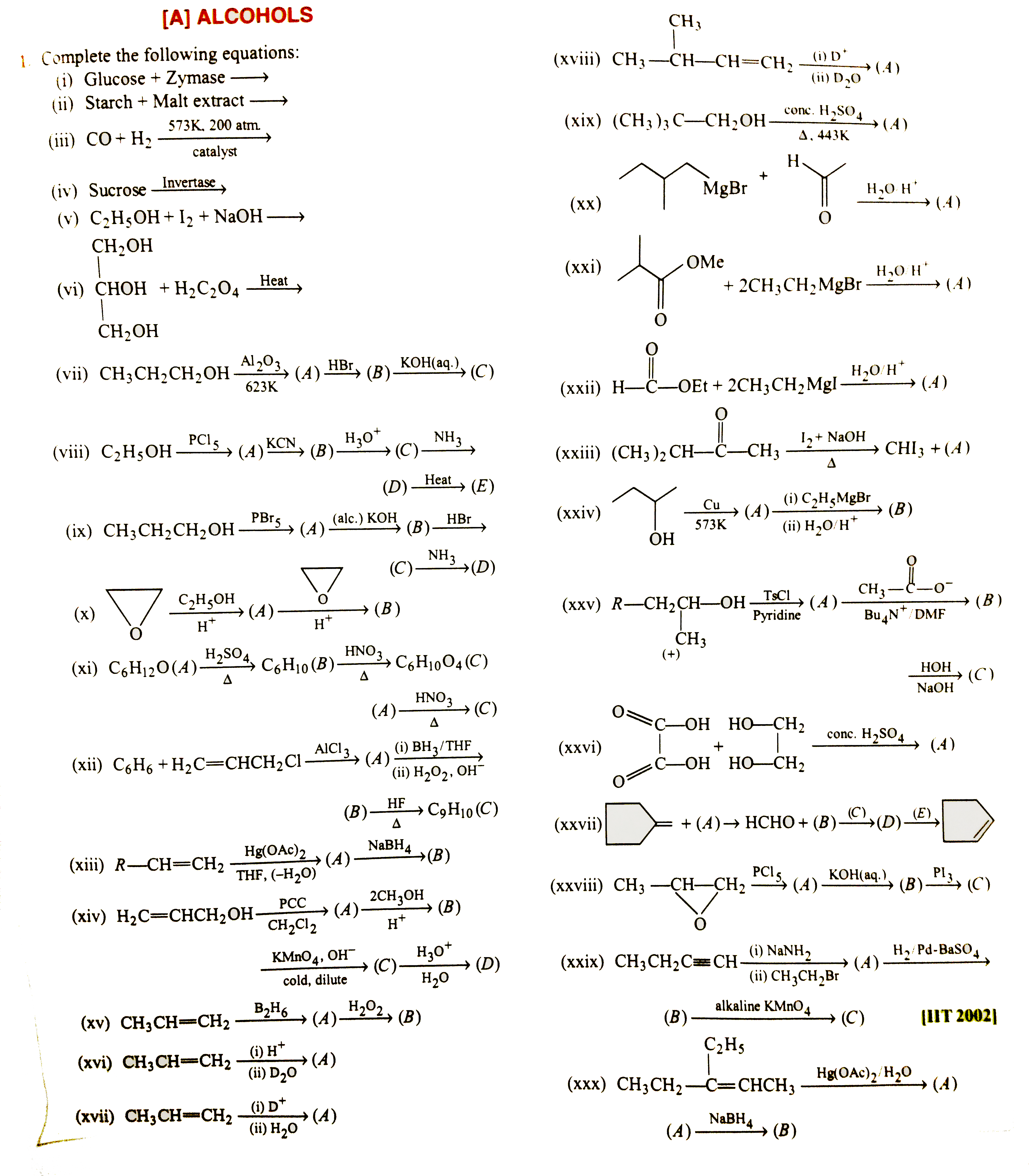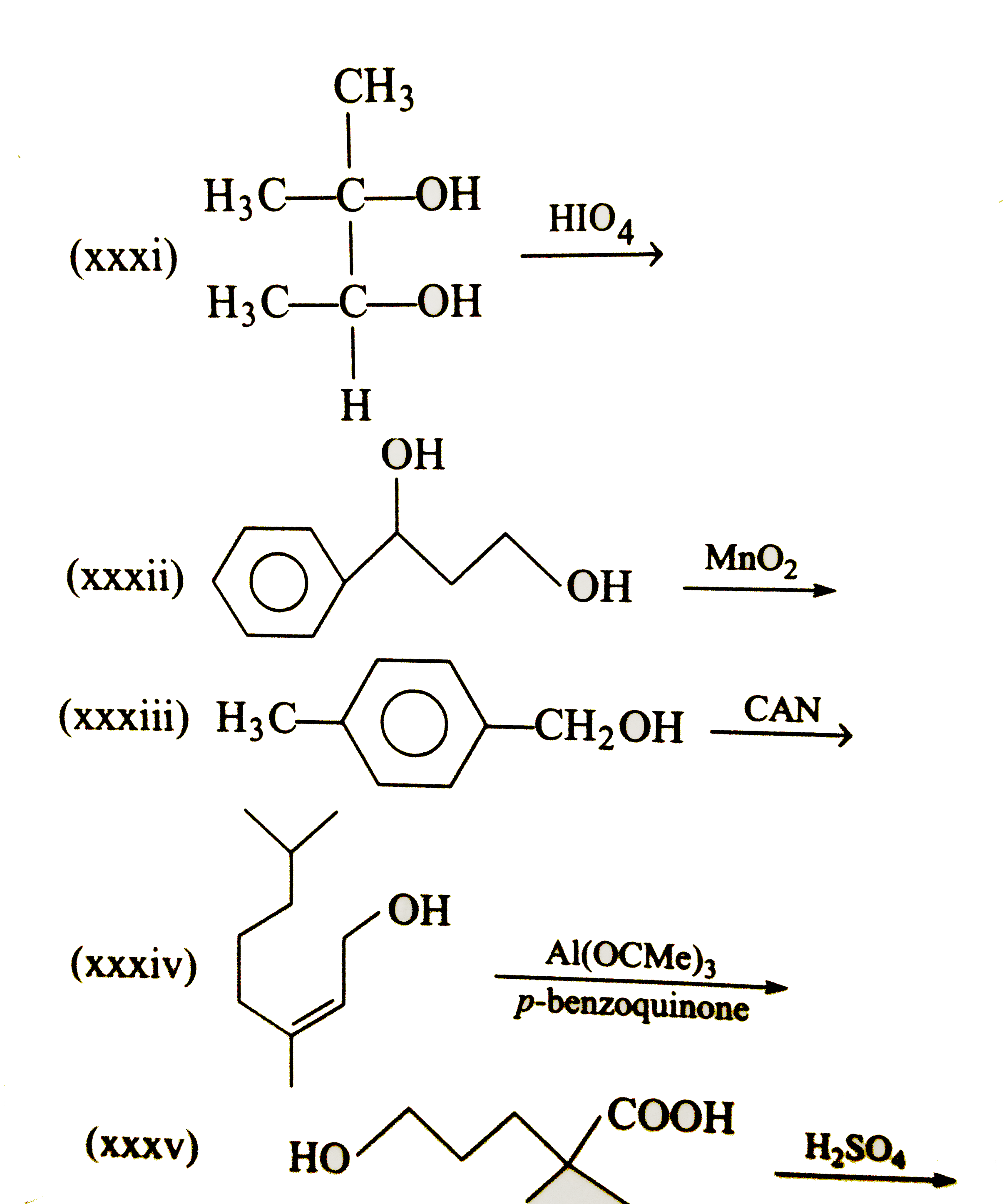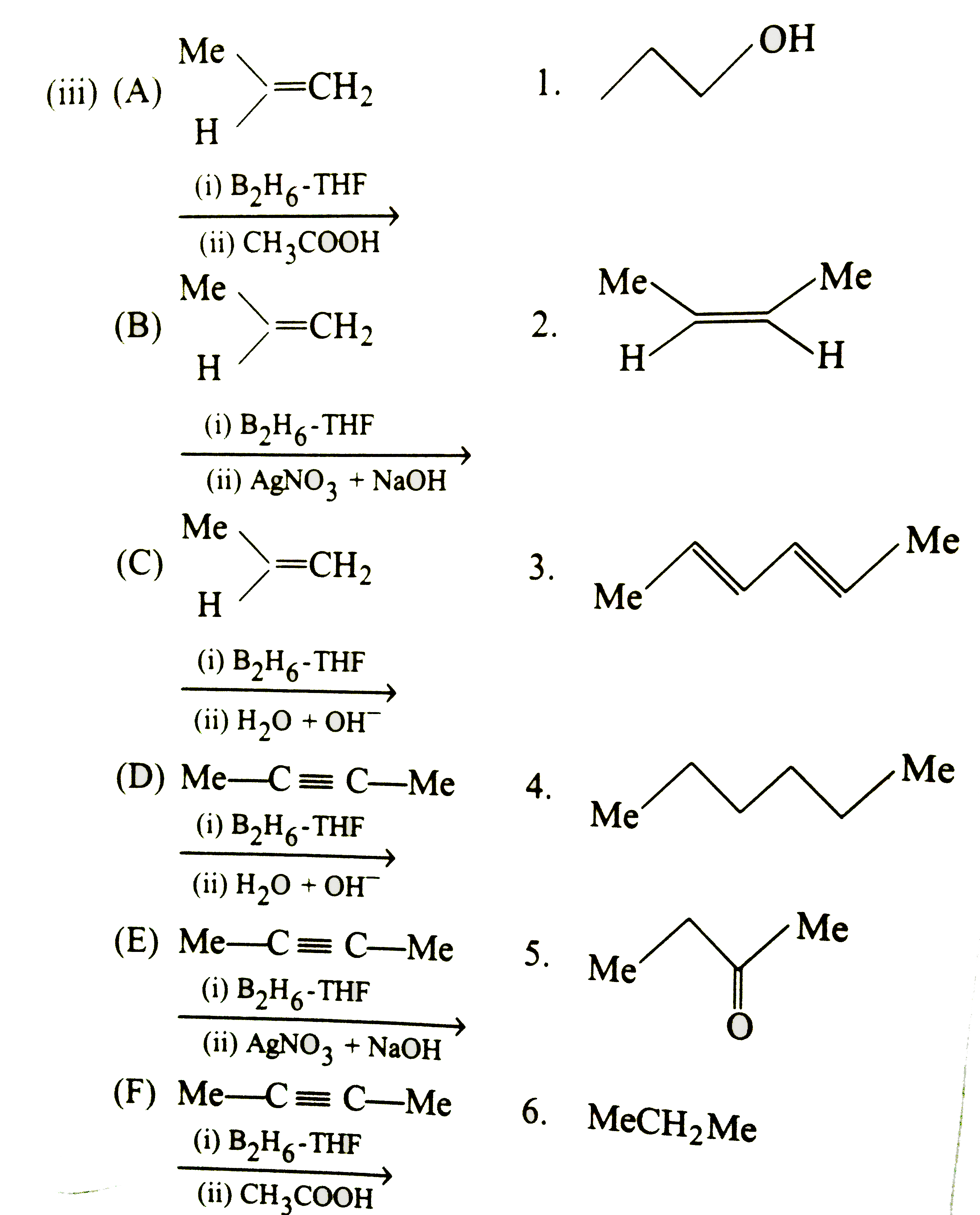A compound (X) containing C,H and O is unreactive towards sodium. It does not added up bromine. It does also not react with Schiff's reagent. On refluxing with excess of HI,(X) gives only (Y).(Y) on hydrolysis gives (Z) which can be converted to (Y) by the action of P and I2. Compound (Z) on oxidation gives an acid of equivalent mass 60. What are (X), (Y) and (Z) ?
To solve the problem, we need to identify the compounds X, Y, and Z based on the given information. Let's break down the clues step by step.
Step 1: Analyze Compound X
- Information Given:
- Compound X contains C, H, and O.
- It is unreactive towards sodium, does not add bromine, and does not react with Schiff's reagent.
Conclusion:
- Since it does not react with sodium, it is not an alcohol (alcohols typically react with sodium).
- The lack of reaction with bromine indicates that it is not an unsaturated compound (alkenes or alkynes).
- The non-reactivity with Schiff's reagent suggests it is not a carbonyl compound (aldehydes and ketones react with Schiff's reagent).
Given these clues, the most likely candidate for Compound X is diethyl ether (C2H5OC2H5), which is a saturated compound and does not react with the mentioned reagents.
Step 2: Identify Compound Y
- Information Given:
- On refluxing with excess HI, Compound X gives only Compound Y.
Conclusion:
- Diethyl ether reacts with HI to produce ethyl iodide (C2H5I) as the only product. Therefore, Compound Y is ethyl iodide (C2H5I).
Step 3: Identify Compound Z
- Information Given:
- Compound Y (ethyl iodide) on hydrolysis gives Compound Z.
- Compound Z can be converted back to Y by the action of phosphorus and iodine.
- Compound Z on oxidation gives an acid with an equivalent mass of 60.
Conclusion:
- Hydrolysis of ethyl iodide (C2H5I) produces ethanol (C2H5OH). Thus, Compound Z is ethanol (C2H5OH).
- Ethanol can be converted back to ethyl iodide (Y) by the action of phosphorus and iodine (the process of iodination).
- When ethanol is oxidized, it forms acetic acid (CH3COOH), which has an equivalent mass of 60.
Final Identification
- Compound X: Diethyl ether (C2H5OC2H5)
- Compound Y: Ethyl iodide (C2H5I)
- Compound Z: Ethanol (C2H5OH)
Summary of the Solution
1. Compound X is diethyl ether (C2H5OC2H5).
2. Compound Y is ethyl iodide (C2H5I).
3. Compound Z is ethanol (C2H5OH).
- Information Given:
- Compound X contains C, H, and O.
- It is unreactive towards sodium, does not add bromine, and does not react with Schiff's reagent.
- Since it does not react with sodium, it is not an alcohol (alcohols typically react with sodium).
- The lack of reaction with bromine indicates that it is not an unsaturated compound (alkenes or alkynes).
- The non-reactivity with Schiff's reagent suggests it is not a carbonyl compound (aldehydes and ketones react with Schiff's reagent).
- Information Given:
- On refluxing with excess HI, Compound X gives only Compound Y.
- Diethyl ether reacts with HI to produce ethyl iodide (C2H5I) as the only product. Therefore, Compound Y is ethyl iodide (C2H5I).
- Information Given:
- Compound Y (ethyl iodide) on hydrolysis gives Compound Z.
- Compound Z can be converted back to Y by the action of phosphorus and iodine.
- Compound Z on oxidation gives an acid with an equivalent mass of 60.
- Hydrolysis of ethyl iodide (C2H5I) produces ethanol (C2H5OH). Thus, Compound Z is ethanol (C2H5OH).
- Ethanol can be converted back to ethyl iodide (Y) by the action of phosphorus and iodine (the process of iodination).
- When ethanol is oxidized, it forms acetic acid (CH3COOH), which has an equivalent mass of 60.
- Compound X: Diethyl ether (C2H5OC2H5)
- Compound Y: Ethyl iodide (C2H5I)
- Compound Z: Ethanol (C2H5OH)
1. Compound X is diethyl ether (C2H5OC2H5).
2. Compound Y is ethyl iodide (C2H5I).
3. Compound Z is ethanol (C2H5OH).
Topper's Solved these Questions
- ALCOHOLS, PHENOLS AND ETHERSBook:OP TANDONChapter:ALCOHOLS, PHENOLS AND ETHERSExercise:PROBLEM FOR PRACTICE
Explore 19 Videos
- ALCOHOLS, PHENOLS AND ETHERSBook:OP TANDONChapter:ALCOHOLS, PHENOLS AND ETHERSExercise:Matching Type
Explore 2 Videos
- ALCOHOLS, PHENOLS AND ETHERSBook:OP TANDONChapter:ALCOHOLS, PHENOLS AND ETHERSExercise:ILLUSTRATION OF OBJECTIVE QUESTINS
Explore 12 Videos
- ALDEHYDES AND KETONES Book:OP TANDONChapter:ALDEHYDES AND KETONES Exercise:SINGLE INTEGER ANSWER TYPE QUESTIONS
Explore 10 Videos
Similar Questions
Complete the following equations :


View SolutionMatch the following :
(A)Fermentation1.Secondary(B)Dynamite2.Methyl alcohol(C)Absolute alcohol3.ZnCl2+HCl(D)Glycerine4.Dihydric alcohol(E)Wood spirit5.Nitroglycerine(F)Lucas reagent6.Propane-1,2,3-triol(G)Propan-2-ol7.100%ethyl alcohol(H)Glycol8.Invertase
(ii) (A)Methylated spirit1.Elimination(B)Enzyme2.Bouveault Blanc reduction(C)C2H5OH+conc.H2SO43.Antifreeze(D)Lucase test4.Esterification(E)Glycerol5.Fenton's reagent(F)RCHONa/C2/N5OH−−−−−−−−−→6.Zymase(G)FeSO4+H2O27.Denatured alcohol(H)C2H5OH+CH3COOH in presence of H2SO48.Tertiary alcohol

View SolutionGive the IUPAC names of the following :

View SolutionIsomeric aldehydes and ketones having the formula C5H10O are :
View SolutionA compound 'X' containing C, H and O is unreactive towards sodium. It does not add with bromine. It also does not react with Schiff's reagent. On refluxing with an excess of HI, 'X' yields only one oragnic product 'Y'.'Y' on hydrolysis yield a new compound 'Z' which can be converted into 'Y' by reaction with red phosphorus and iodine. the compound 'Z' on oxidation with potassium permanganate gives a carboxylic acid. The equivalent weight of acid is 60. What are the compounds 'X','Y' and 'Z'? Write chemical equations leading to the conversion of 'X' to 'Y'.
View SolutionIn the compound gives below, the correct order of acidity of the positions (X), (Y) and (Z) is
View SolutionA compound (W) containing only C,H and O is unreactive towards sodium .It does not add bromine . It also does not reacts with Schiff's reagent . On refluxing with excess of hydroiodic acic. (W) yields only one organic product (X). On hydrolysis (X) yields a new compound (Y) which can be converted to (X) by reaction with red phosphorus and iodine . The compound (Y) on oxidation with potassium permanganate gives a carboxylic acid (Z), with a equivalent weight 60. What are (W),(X),(Y) and (Z) ?
View SolutionCompound (X) C_(6)H_(5)O gives yellow coloured ppt with 2,4 DNP but does not give red colored ppt with Fehiling's solution (X) on treatement with NH_(2)OH H^(+) gives compound (Y) C_(6)H_(5)NO (Y) when treated with PCl_(5) gives isomeric compound (Z) . (Z) on hydrolysis gives propanoic acid and aniline. what will be the correct structure of (X) ,(Y) and (Z) ?
View SolutionA compound 'X' on heating with excess conc. Sulphuric acid at 443K gives an unsaturated compound 'Y'. 'X' also reacts with sodium metal to evolve a colourless gas 'Z'. Identify 'X', 'Y' and 'Z'. Write the equation of the chemical reaction of formation of 'Y' and also write the role of sulphuric acic in the reaction.
View SolutionAn oxide of a bivalent metal on heating with coke gives a compound 'X' and a gas 'Y'. The gas 'Y' reacts with chlorine gas to give a poisonous gaseous compound. 'X' undergoes hydrolysis to give a hydrocarbons 'Z' with two carbon atoms. Identify the compound X,Y, and Z. Also give the reactions involved.
View SolutionA compound (X) containg C,H , and O is unreactive towards sodium. It does not add with bromine. It also and excess of Hl, (X) yields only one organic product (Y), (Y) on hydrolsis yield s a new compond (Z) whch can be converted to (Y) by reaction with red phosphours and permangnate gives a carboxlic acid. The equivalanet weight of this acid is 60. What are the compounds (X) , teh conversion of (X) to (Y) .
View SolutionPrimary alkyl halide C4H9Br (X) reacts with alc. KOH to give compound (Y). (Y) reacts with HBr to give compound (Z) which is an isomer of (X). When (X) reacts with Na metal it gives compound (P). (X), (Y), (Z) and (P) are
View SolutionA metal M reacts with sodium hydroxide to give a white precipitate X which is soluble in excess of NaOH to give Y. Compound X is soluble in HCI to form a compound Z. Identify M.X,Y and Z
M , X , Y, Z
View SolutionA compound X on treatment with Na gives Y and with PCl_5 gives Z. Y and Z react together to give diethyl ether , X,Y and Z are respectively ___________.
View SolutionX,Y and Z are amines . Only Z and Y react with acetic anhydride . Only Z gives carbylamine reaction . Then X,Y and Z are respectively,______.
View Solution

